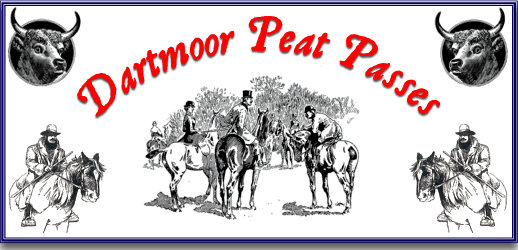
The northern part of Dartmoor is the source of several rivers and most of the high land is termed ‘blanket bog’ or Fen. Anybody who has tried to cross the heart of the Fen will know that if on foot it can be a ‘pig’ to traverse especially in wet weather. The whole area is covered by bogs, peat gullies, tussocks, hidden holes, and other such delightful surprises. Imagine then if you were on horseback and trying to do the same – nightmare or what? If it is (and it is!) that bad why should be people be daft enough to try and take a horse or pony across such terrain? The Fen has always been used for cattle grazing and so there would also be occasions when it was necessary to drive the stock to the lairs or grazing areas, there would also be times when somebody wanted to bring cattle off the moor, both situations would involve riders and horses. The Northern Fen has also been a popular area for fox hunting and so once again the hunt and its followers would often give chase on horseback across the fen.
Many of the old moormen knew the drier and flatter routes to take which was fine for them but what of people less well acquainted with the terrain?
Enter William Francis Phillpotts (aka Frank). Born in 1837, Phillpotts was the grandson of the Bishop of Exeter and a distant relation of the famous author Eden Phillpotts. He was educated at Winchester College and then New College during which time he developed a fondness for field sports, especially shooting and hunting. In 1864 he was called to the Bar and for several years reported for The Times, later he practiced in the Chancery Courts. All in all he was on his way to the top until he caught a chill and did not bother getting any treatment. The following illness cost him his hearing which meant he was confined to conveyancing and routine legal work. Despite his handicap and busy workload he continued with his passion of horse riding and would often visit Devon to compete in local point-to point races or ride with the hunt. Phillpotts was winning point-to-points at the age of 65 and still competing at the age of 71. The great man died at the age of 72 in 1909 but has left a legacy to this day.
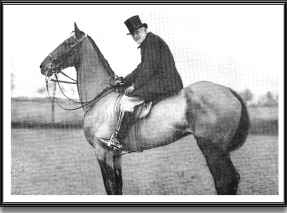
Frank Phillpotts 1908 – aged 71
Frank Phillpotts was a keen huntsman and knew only too well the pleasures and dangers of riding across the Northern Fen. If the chase led across the moor it was soon halted as soon as the fox ran into the fen. The ground here was too treacherous to ride a horse over which meant the wily old fox could make good its escape. Phillpotts also had a good local knowledge of the northern terrain and knew of areas where the peat had been eroded down to the granite bedrock. He then had the idea to link up these eroded areas by cutting away the intervening peat thus forming a ’causeway’. This was not a new idea for the old moormen had been doing this for centuries but only in certain places. So between the years of 1895 and 1905 Phillpotts directed a team of moormen to make these ‘cuts’ or ‘passes’. They only worked in the summer months and had bases at Headland Warren and then Fernworthy.
Once the peat passes were cut it soon became obvious that some sort of marker was needed to enable people to find them, especially in mist and fog. At first wooden posts were erected at each end of the pass but a combination of rotting and animals using them as rubbing posts soon destroyed the poles.
After the death of Frank Phillpotts, his brother the Rev. J. S. Phillpotts and his son Raleigh Phillpotts paid for a number of granite maker stones. These were cut by the Duke’s Quarry at Merrivale and taken out to the moor by George French and his pack-horse. For some odd reason there were not enough maker stones made and so it was supposed that the Okement Hill cut was never marked. The 17 stones were all sited by 1919 and the last 2 to be erected were at the Walkham Head Cut. Each granite pillar had a bronze plaque fixed to it explaining what it was, the plaques were made by Vickers, Maxim and Co.
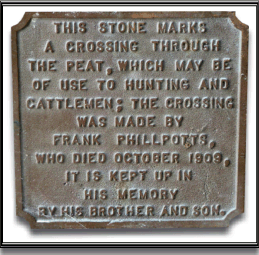
A Peat Pass Marker Plaque.
The markers stones were 2ft 6 in. high, 5 in. thick and 7 in. wide. The plaques measure 6 in. by 6 in. The granite pillars were either placed in peat banks or small stone cairns.
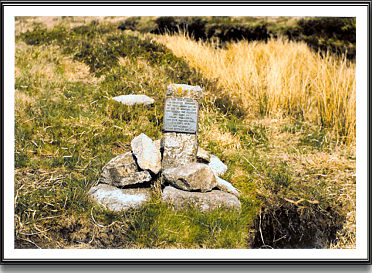
A Peat Pass Marker In-situ – North West Passage.
When first cut the passes helped many moor travellers to transverse the fen, the hunts found they could chase the foxes further and the moor farmers found the movement of livestock at lot easier. They would also have been of use to any ramblers of the time. The only problem with the passes was due to the weather and animals the peat soon eroded and choked up the causeways and blocked the drainage gutters. The annual maintenance work was undertaken by the Mid-Devon Hunt. In the 1920’s Raleigh Phillpotts attempted to create a new cut from the East Dart across to the southern slopes of Black Hill to the rear of Little Kneesett. This was called the ‘Lamerton Lane’ as it led to the Lamerton Hunt country. This project was not completed and was abandoned until 1958/9 when further attempts were made to open the pass, these too failed and the pass was never completed.
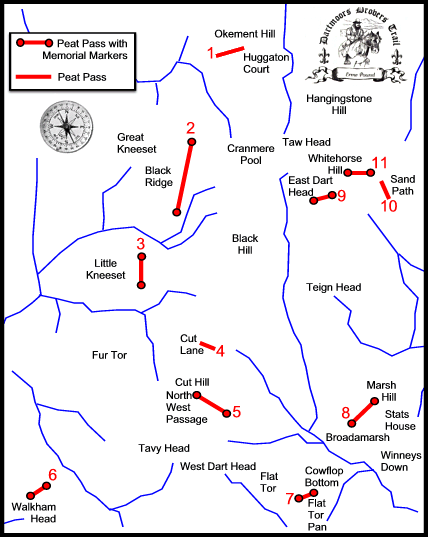
Map showing the peat passes and cuts of Dartmoor.
The above map shows the 11 passes on the Northern Fen, 9 of which are true Phillpotts peat passes (i.e. with memorial markers or cut under the guidance of Phillpotts) and below is a short description of each one:
1. Okement Hill – SX 603869 – 601868.
From east to west the cut is about 230 yards long. As mentioned above this peat pass was supposed not to have been marked with Phillpotts stones. However, about six years ago the top of one suddenly appeared at the west end of the pass. It comprised of the top twelve inches and the bronze plaque, this has now vanished again. The pass is also variously known as ‘Huggaton (old Dartmoor name for Okement) Cut’ or Hammond’s Cut’.
2. Black Ridge – SX 597858 – 595849.
From north to south the pass is roughly 1,100 yards long and is by far the largest. The are two branches of the cut but the eastern one is the original. Small cairns mark some of the open stretches but these seem disappear and re-appear at will.
3. Little Kneeset – SX 592844 – 592841.
From north to south the cut is roughly 450 yards long and is one of the more open of the passes.
4. Cut Lane – SX 599832 – 587832
From east to west the ‘lane’ is about 240 yards long. This was not a Phillpotts peat pass as it is an ancient cut that links the Tavy and East Dart countries. Being so close to the letterboxing ‘Mecca’ of Cut Hill it can be a busy place.
5. The North-West Passage – SX 603822 – 603823; 602824 – 598827
From east to west the pass comprises of two sections linked by a natural, grassy corridor. The combined length of both parts is about 500 yards. The enigmatic name is said to have been given to the cut by Mr Sam Adams who was master of the Lamerton Hunt from 1896 -1904. This is another passage where the marker stones come and go. One of the markers stones was re-discovered in the summer of 2002.
6. Walkham Head – SX 579815 – 578814
From east to west this cut is approximately 150 yards long and as proof of its use by the moormen a ‘ring rock’ (a boulder with an iron ring affixed, used for tethering horses) can be seen about 300 yards north east of the eastern entrance to the pass.
7. Flat Tor – SX 613814 – 612813
From east to west the pass is roughly 200 yards in length. Although not shown on the O.S. map the cut begins at Cowflop (old Dartmoor name for the foxglove) Bottom. It had suffered much at the hands of the tinners but the causeway linked several stretches of good ground.
8. Marsh Hill – SX 620826 – 617823
From east to west the passage is about 350 yards and comprises of sections linking firm ground. Roughly 100 yards from the eastern end is ‘Stat’s House’, this is the ruins of a moorman’s shelter probably used by peat cutters.
9. East Dart Head – SX 614852 – 613851
From east – west the cut is around 40 yards long and links with the Whitehorse Hill pass.
10. The Sand Path – SX 621854 – 622852
From north to south this 220 yard cut is another ancient path constructed before the Phillpotts Peat Passes. It runs off at almost 90º to the Whitehorse Pass which is some 180 yards to the north west.
11. Whitehorse Hill – SX 619854 – 617854
From east to west this pass runs for some 270 yards. This now is probably one of the better constructed passes as it was cleared with a bulldozer in 1963 when the military were building a new observation post. This also linked up with some firm ground to the military ring road at Hangingstone Hill. Nearby is another ruined moorman’s shelter called ‘Moute’s Inn’.
These days many of the peat passes have become clogged up with eroded peat and the gutters choked, indeed some of the smaller ones can be quite hard to distinguish. As mentioned, many of the stone markers have a habit of vanishing and re-appearing but many are still in place albeit missing their plaques. The passes to this day will save the walker from an arduous journey across the Fen and possibly a good soaking!
Le Messurier, B. 1965 The Phillpotts Peat Passes of the Northern Fen, Devonshire Association Vol. 97, Devonshire Press, Torquay.
 Legendary Dartmoor The many aspects past and present of Dartmoor
Legendary Dartmoor The many aspects past and present of Dartmoor
